Dear Readers,
When Ray Kurzweil first said that by 2029, machines would match human intelligence, and by 2045, we would merge with them, it sounded like science fiction, equal parts awe and hubris. Yet each passing year seems to drag his “law of accelerating returns” closer to the center of reality. The exponential curve no longer lives in obscure graphs; it’s visible in the speed of AI breakthroughs, the biology labs reprogramming aging, and the compute farms scaling faster than nations can regulate. What once felt like prophecy now feels like the front edge of daily news.
In today’s issue, we trace the arc of Kurzweil’s predictions - from his early inventions and eerily accurate calls on mobile computing to his enduring bet on the Singularity. You’ll see where his vision holds, where it overreaches, and why his ideas still shape how Silicon Valley - and increasingly the world - imagines our future. Whether you find him a prophet, an optimist, or a provocateur, one truth remains: the dates he set are approaching, and this decade will decide how right he was.
All the best,


Ray Kurzweil - His Person and Forecasts
“Today, we have one brain size which we can’t go beyond to get smarter. But the cloud is getting smarter and it is growing really without bounds. The Singularity, which is a metaphor borrowed from physics, will occur when we merge our brain with the cloud. We’re going to be a combination of our natural intelligence and our cybernetic intelligence and it’s all going to be rolled into one. Making it possible will be brain-computer interfaces which ultimately will be nanobots – robots the size of molecules – that will go noninvasively into our brains through the capillaries. We are going to expand intelligence a millionfold by 2045 and it is going to deepen our awareness and consciousness.”
(Ray Kurzweil, 2024, Interview in The Guardian)
Take an ambitious promise, repeat it for three decades, and watch the world inch toward it, this has been Ray Kurzweil’s strange advantage. Long before “GPT” turned into shorthand for the near-future, Kurzweil stood on conference stages and in dense books arguing that computation grows on an exponential curve, and that this curve drags everything with it: language, medicine, energy, even mortality. He did not only sketch destinations; he gave dates. In 1990s he forecast computers beating humans at chess (met in 1997) and a planet laced together by mobile, always-on networks (met in the 2010s). He then went further: by 2029, he said, machines would match human intelligence across domains (”AGI”); by 2045, we would merge with them in a “Singularity,” expanding our minds a million-fold through brain-computer interfaces and cloud intelligence.
This article looks past the carnival of hype to a practical question: when you check Kurzweil against the historical record, how much of his map has held, where did he get ahead of himself, and what would it actually mean if his two anchor dates, 2029 and 2045, land roughly on time? The inquiry is less about canonizing a prophet and more about testing a model of the future that still shapes how scientists, investors, and policymakers think about AI.


Subscribe to Superintel+ to read the rest.
Become a paying subscriber of Superintel+ to get access to this post and other subscriber-only content.
UpgradeA subscription gets you:
- Discord Server Access
- Participate in Giveaways
- Saturday Al research Edition Access

